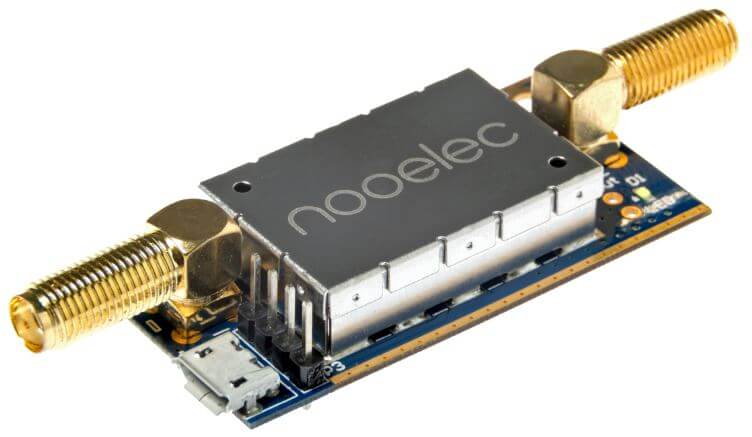New LNA + Filter for Radio Astronomy Hydrogen Line Observations Released by NooElec
NooElec have recently released a new LNA + filter combo called the "SAWbird+ H1 Barebones" which significantly lowers the entry bar for new amateur radio astronomers. It's designed to be used with RTL-SDR or other SDRs for radio astronomy, and in particular reception of the Hydrogen line.
The filter is centered at 1.42 GHz with a 70 MHz bandpass region. The LNA has a minimum gain of 40dB. For hydrogen line observations it is important that the LNA have very low noise figure, and this LNA fits the bill with a ~0.5dB to ~0.6dB noise figure. An additional feature on the PCB is an RF switch that is electrically controlled via expansion headers. This switch allows you to switch out the LNA for a 50 Ohm reference which is useful for calibration in more serious radio astronomy work.
This LNA draws 120mA of current meaning that it will work with the RTL-SDR V3 and Airspy's bias tee, but probably not with the SDRplay's bias tee which is limited to 100mA and seems to trip a fuse at higher current draws. For an SDRplay you could use external power instead, although you will need an additional DC blocking cap to prevent power from entering the SDR and destroying the ESD diodes.
If you don't know what the Hydrogen line is, we'll explain it here. Hydrogen atoms randomly emit photons at a wavelength of 21cm (1420.4058 MHz). Normally a single hydrogen atom will only very rarely emit a photon, but space and the galaxy is filled with many hydrogen atoms so the average effect is an observable RF power spike at 1420.4058 MHz. By pointing a radio telescope at the night sky and integrating the RF power over time, a power spike indicating the hydrogen line can be observed in a frequency spectrum plot. This can be used for some interesting experiments, for example you could measure the size and shape of our galaxy. Thicker areas of the galaxy will have more hydrogen and thus a larger spike. You can also measure the rotational speed of our galaxy by noting the frequency doppler shift.
Although this LNA lowers the entry bar, in order to receive the Hydrogen line with the SAWBird+ H1 you will still need a ~1m+ satellite dish and a feed tuned to 1.42 GHz or high gain Yagi, horn or helical antenna. Antennas and feeds like this are not yet available off the shelf, but if you search our blog for "hydrogen line" you'll see many project examples.

I am VERY happy to see this thing officially announced. I’ve been working with NooElec on prototypes and Beta units of this device for the last year, and have been very pleased with it.
Our little endeavor has used this device to produce a good-quality sky-map at 21cm this past summer, that is 98% complete: http://www.ccera.ca/files/21cm.png
Wow very very cool image! Hoping a write up on how that image came to be is coming?
Yes, we plan to add a write-up to our MEMOS series:
http://www.ccera.ca/files/memos/
Watch for it in the coming month or two as the map is completed.
Cheers
Marcus
Sagittarius A is located at about RA: 17h 45m Dec: -29°. It looks like it is at about Dec: 45° on your map.
The Airspy quickstart guide ( https://airspy.com/quickstart/ ) gives the “The Bias-Tee option” as “4.5v @ 50mA”, I know that they now under clock the MCU (for less noise), so maybe there is more power available since that number was published.
You could also use a Airspy HF+, and I think discovery as well, (with an external bias-T source) since it can unofficially receive L-Band from 1.2 GHz to 1.67 GHz. But at a maximum ( hidden ) sample rate of 912 ksps (firmware R2.8.0 https://airspy.com/downloads/hfplus_changelog.txt ) it is probably not as useful for H line observations.
I was looking at the image on https://airspy.com/airspy-r2/. Says 4.5V/0.25A, so that’s more than enough. I’ve tested the Airspy with our ADS-B LNA which also needs 120mA and it works fine long term.
I suspect that is the maximum rating for the LDO (Low-dropout regulator) used. So if more than the maximum rated current, of 500 mA, is available from the USB 2.0 port (say 700 mA) then all is well. And that the 50mA projectilefish.5V is the maximum that can drawn if the USB 2.0 port is only able to provide the maximum rated current of 500 mA within the USB 2.0 standard. So it depends on the computer used and the way that the power is provided to each USB port, if 550 mA and be provided.
projectilefish.5V is the maximum that can drawn if the USB 2.0 port is only able to provide the maximum rated current of 500 mA within the USB 2.0 standard. So it depends on the computer used and the way that the power is provided to each USB port, if 550 mA and be provided.